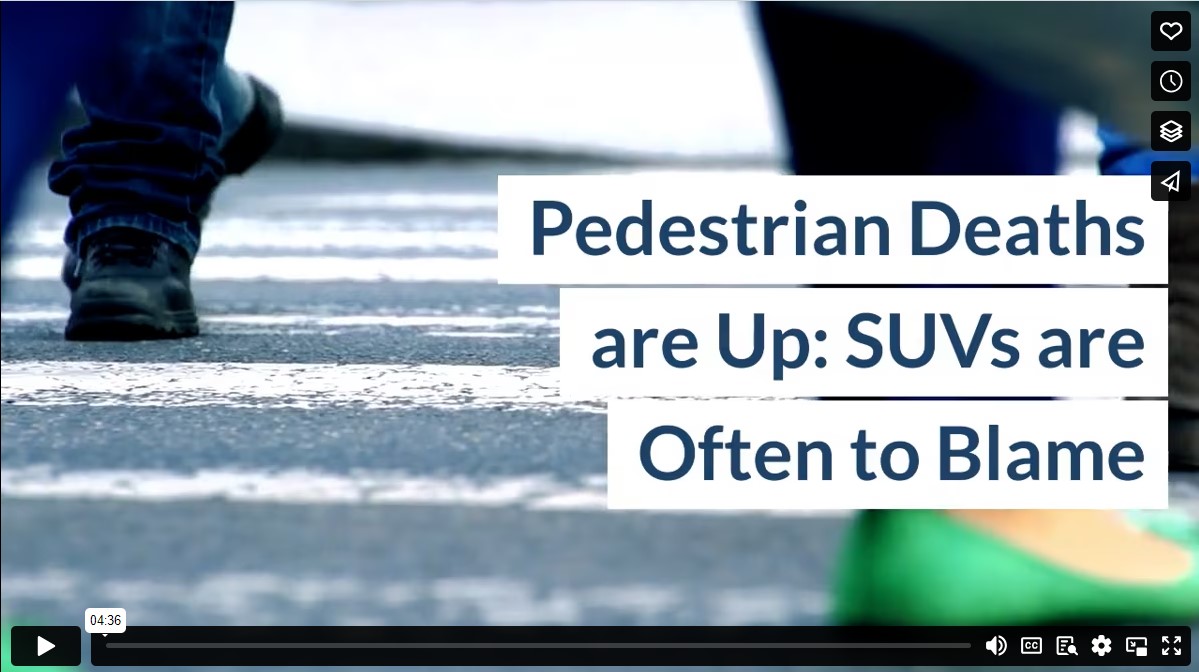It’s noon on a sunny day when Susan walks from work to a cafe two blocks over. She waits for the crosswalk sign to indicate it’s her turn, but as she crosses the street, an SUV in the left turn lane hits her, seriously injuring her.
Sadly, accidents like this are becoming more and more common.
In the past decade, pedestrian deaths have increased by a staggering 77%, compared to other traffic fatalities which increased by 25%. One significant contributor is SUVs.
SUVs are becoming increasingly popular. (JD Power has reported that over 80% of new cars sold in America are either SUVs or pickup trucks.) These big vehicles are causing death and injuries to pedestrians at higher rates than small cars. Research shows that SUVs are 16% more likely to cause incapacitating injuries and 36% more likely to kill pedestrians than smaller cars. Pickup trucks are even more damaging as they are 33% more likely to cause incapacitating injuries and 108% more likely to kill pedestrians.
A Perfect Storm
A perfect storm is defined as “a particularly violent storm arising from a rare combination of adverse meteorological factors.”
You have a similar situation in left turn SUV or truck vs. pedestrian or cyclist accidents. It’s often a combination of factors rather than a single cause that leads to disaster. Here’s a closer look at some of these factors.
- A-Pillar Blindness. There are four SUV pillars,or structures supporting the vehicle’s roof.
- A-pillar supports the windshield.
- B-pillar is the support between the front and back doors.
- C-pillar supports the back window at the end of a car. C-pillar allows the vehicle to support one more row of passenger seats on an SUV or van.
- D-pillar then supports the back window.
As vehicles get bigger, the supports naturally get wider. The pillar must hold up the metal roof and maintain its structure if the vehicle rolls so it doesn’t collapse on the passengers.
As an added safety feature, auto makers installed airbags in the A-pillar to protect the driver and front-seat passenger in an accident. This makes it wider and thicker to accommodate the airbag.
Unfortunately, our eyes take in a broad panorama view of the world through lenses 2-4mm wide. Distance makes a huge difference in how much we can see. Take a flashlight, for example.
- Turn on your flashlight in a dark room. The lit area grows with distance like a “V,” with the narrow end starting at the light source and the broad end against a wall four feet away.
- Hold a pencil up to the wall four feet from the flashlight. It obstructs the light (or your view) and creates a shadow the size of the pencil.
- Hold the same pencil directly against the glass of the flashlight four feet from the wall, creating a much bigger shadow (or blind spot).
The A-pillar is wide and close to our face, creating a v-shaped blind spot that gets wider the farther away you get from the car. From the left turn lane, you can have a blind spot as wide as seven feet on account of the A-pillar.
- Turn Angle and Speed: When a long vehicle makes a turn, it takes a broader arc. They can enter the crosswalk anywhere between the median line to the opposite sidewalk with up to three lanes of width, making the entry point unpredictable.Because the left turn takes longer than a right turn, the car builds up more speed before it reaches the crosswalk. More speed means less reaction time when the person hiding in the blindspot shows up in the windshield’s view. It also means the vehicle collides with the pedestrian or bicyclist at a greater speed, creating a more significant impact.
- Vehicle Height: SUVs and trucks are taller than other vehicles, making it harder to see animals, children, and shorter adults as they move out of the blind spot.The height also affects the scope of the injuries. The vehicle can impact a more significant portion of the body, including the stomach, chest, and head, where all your vital organs are. A small car hits an adult in the legs. It can break legs, but unless you sever the major artery, the chance of survival is much higher from a small car impact than from a large car impact that hits between the hips and head.
Driver Responsibility
As any reasonable auto accident attorney will tell you, the fact that truck and SUV drivers have all these factors working against them doesn’t absolve them from responsibility when they hit a pedestrian or cyclist. When they choose to get behind the wheel of a vehicle, they are responsible for all accidents they cause short of mechanical failure.
If you own an SUV or truck:
- Be sure the crosswalk is clear. You can lean forward and back to change where the blind spot hides the crosswalk or even stick your head part way out the window, but make sure you see the entire crosswalk before moving forward.
- Watch your speed as you turn. It isn’t a race.
- Be aware of pedestrians and cyclists approaching an intersection that might cross into your path.
If you’ve been hit by a vehicle in the crosswalk, and you live in Utah, you can google “car accident lawyer Salt Lake City” or click HERE. You can also look for “car accident attorney near me.” A qualified attorney can help you get the medical care you need. They can advocate for you to get the financial damages for the pain and injuries you have sustained and may continue to suffer from in the future.
Video

